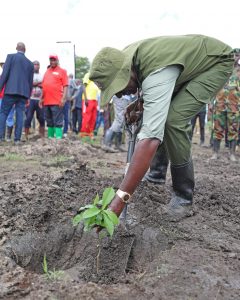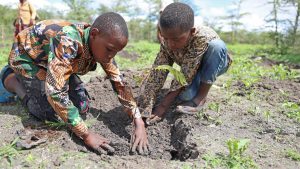By Evaline Wanjiku Kiambuthi
Climate change has become a global concern, and it demands immediate mitigation action. Climate change is defined as the long-term shifts in temperatures and weather patterns. The shifts may be natural or unnatural. Human activities(unnatural) have greatly influenced climate change.
Some of the activities that contribute to adverse climatic changes include the generation of power and heat by burning fossil fuels such as coal, oil, and natural gas; deforestation, which is cutting down forests to create farms, have pastures for livestock or for timber; the use of means of transportation such as vehicles, especially petrol engine vehicles among many others. While these are some of the significant technological advancements, they have come at a greater cost.
Some of these climatic changes are irreversible, especially the effects on our oceans, ice sheets, and global sea levels. In recent years, there has been increasing evidence of climate changes, including extreme heatwaves, heavy precipitation, droughts, tropical cyclones, earthquakes, floods, and reductions in Arctic Sea ice, snow cover, and permafrost. Due to the industrial revolution, there has been an increasing rate of greenhouse gas emissions, leading to global warming. Global warming occurs when carbon dioxide and other air pollutants collect in the atmosphere, absorbing sunlight and solar radiation that have bounced off the Earth’s surface rather than escaping into space. Hence, the heat is trapped, causing the Earth to be warmer. The dependence on industrial developments for day-to-day life has increased the risk of climate change globally, and third-world countries are at risk of facing more impact of climate change.

Recently, the world celebrated a tree-planting day on 13th November, 2023 and in Kenya it was led by His Excellency the President, Hon. William Ruto. However, while the activity is commendable, majority of us, especially living in urban centers and those in rural areas alike, could not participate. It was just another day off of work, another day to escape the noise and have a minute to breathe in this choking economy. The cost of oil has increased as the value of the shilling is dropping, and people are busy thinking about the next thing that will be taxed. For the record, it is important to remember where your Identification card is; it might cost you Ksh 2000 to replace, up from Ksh 100. Among the people I know directly, just two allegedly participated in tree planting. However, that is not the issue. The big question is whether planting trees is a good strategy for climate change and whether we can expect changes once the trees are grown. The answer might be no!
Today, Kenya is facing high rates of deforestation. Since independence, Kenya’s forest cover has dropped from 10% of the nation to 6%, losing approximately 12,000 hectares annually. According to Global Forest Watch, from 2002 to 2022, Kenya has lost 50.7 kha of humid primary forest, which makes up about 14% of its total tree cover loss in the same period. Kenya’s total area of humid primary forest has decreased by 7.8%. Mostly, it results from deforestation and forest degradation, fueled by poverty. While our needs might be the driving force, as a country, we are slowly losing our water catchment areas, which is reflected in water and electricity shortages in major cities; some areas have experienced floods, and our biodiversity is slowly but surely disappearing.
While most of us may think that planting trees may solve our climate issues, it is important to understand that planting trees can only benefit future generations. Trees are important to our ecosystem because they remove carbon dioxide from our atmosphere through photosynthesis. However, by planting them today, we might need to live longer to see its impact on climate. We mostly assume that new trees will automatically impact the carbon dioxide levels in the atmosphere, and we will start experiencing better weather patterns or have quality oxygen! However, scientists say new trees absorb less carbon dioxide from the atmosphere than older trees and they are yet to adapt fully to the changes in the environment.
Similarly, old trees can absorb carbon dioxide better compared to new trees. Although trees become less efficient at processing carbon as they age, they have more leaves to absorb Carbon dioxide. Moreover, trees in natural forest have developed their biodiversity and can sustain life within themselves, compared to a planted forest, especially in areas that are not naturally adept at sustaining trees. According to research, younger trees are more sensitive to changing climatic conditions such as rainfall and sunshine and are yet to ‘be used to’ the environment. It would also take about 120 years for a planted forest to grow its biodiversity, according to Mongabay. On the other hand, the biodiversity of natural forests like tropical forests has the potential for regrowth if left untouched by humans for about 20 years, according to The Guardian. This is because there will be a secondary succession where the old forest flora and fauna will help the new generation of forest grow. What does this tell us?

While planting trees is valuable and necessary, we should focus more on reforestation. That is, intentionally restocking existing forests and woodlands depleted through deforestation. It could be a mitigation strategy where we focus on restoring the already lost forest rather than directing all the energy to planting a new one. We should re-evaluate our strategies, conserve the natural forest left, and try as much as possible to encourage reforestation. It will help maintain tree diversity and ensure that forest composition and structure are not lost and diverse species are protected. We could count on new trees in the future, but the climate change crisis calls for mitigation strategies that can work as soon as possible.
While reforestation can work theoretically, people must understand the ‘why’ concerning practicality. Why do we need to restore our natural forest? Why forests are important. This can be achieved by educating our citizens, especially those surrounding the forests. We should also take personal initiatives in understanding our roles in conserving our environment and the government should advocate for policies that align with the protection of our forest reserves. If we all have a mutual understanding of climate change and what it is all about, it will be easier to execute strategies geared toward conserving our forests. Knowledge is power, and only if people understand the value of our forests can they follow the strategies provided. Therefore, planting trees may be a start, but it is not a sustainable solution we currently need for the climate change crisis.

